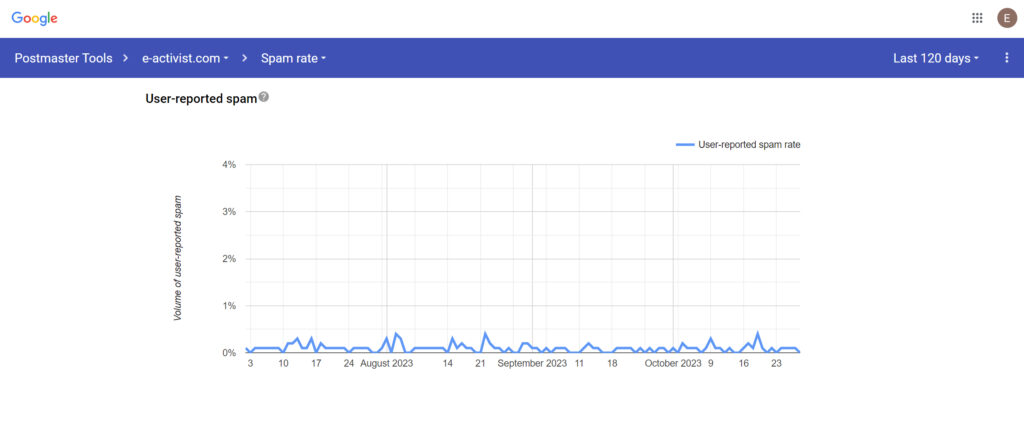New Google & Yahoo Sender Requirements (Q1 2024)
At the start of October, both Google and Yahoo announced plans to release sweeping changes to how they manage email security on their Gmail and Yahoo Mail platforms from Q1 of 2024. Typically we see that these two mailbox providers account for 65-70% of all email addresses on subscriber lists so the impact of these changes will be very significant to say the least. Going by Google’s guidance, we expect the new policies to impact any bulk senders who deliver in excess of 5,000 emails in one day.
While Engaging Networks engineers will be busy auditing all parts of our mail server systems between now and the start of next year to check they fully comply with the new requirements, we already know there are things that you, the senders, can be doing to bring yourselves up to standard with the new requirements between now and then.
Fully Authenticating Your Emails
Most importantly, we strongly advise all clients to fully authenticate any domains they’re using for sending bulk emails, marketing automations or autoresponders from Engaging Networks using our Domain Authentication tool. Both Google and Yahoo list this as a key factor in their security updates so, if you haven’t already (of if you’re unsure whether you have), it’s well worth checking the status of SPF, DKIM and return path alignment for your sender domains.
Google and Yahoo also recommend setting-up DMARC authentication for your domain. Once SPF, DKIM and return path alignment are set-up in Engaging Networks, you’re ready to establish a DMARC record as well. However, while DMARC may then pass for your emails that are sent from Engaging Networks, it doesn’t necessarily mean that DMARC is also correctly set-up for emails that are sent from your domain via other applications/mail servers. For this reason, we recommend that you speak to your IT team about setting-up DMARC as this delivery component falls under your own domain rules and email processing, not the Engaging Networks application. For more on this and further explanation of how DMARC works, please read our Quick Guide to DMARC article.
Set up a Custom Envelope Sender
This update is just as important for emails you’re sending to advocacy targets as it is for the emails you’re sending to your supporters. If you haven’t already, please take the time to set-up a Custom Envelope Sender for your email-to-target (ETT) pages and retroactively assign the envelope to any pre-existing, live ETT pages that are not currently using an envelope. We strongly suspect that unauthenticated ETT emails sent to advocacy targets using Google and Yahoo controlled mailboxes will become completely untenable from Q1 2024 onwards.
Upgrade to the Latest Engaging Networks Email Services
Engaging Networks released new Marketing Tools for email in February of this year and now is the best time to migrate to them from our legacy tools. While we still have complete confidence in our legacy tools, there are certain features (such as ‘domain whitelabelling’ in email body links) that are exclusive to the new Marketing Tools and will provide considerable benefits to clients in the context of these Google/Yahoo updates.
Check Your Unsubscribe Links and Subscription Management Pages
While reviewing our new tools, one final item that all clients should double-check is their set-up for unsubscribe links/subscription management in their email templates (while paying particular attention to list unsubscribes and master opt ins). This is another item that Google and Yahoo will be paying very close attention to under their new requirements, so clients should be sure that these functions are all working as intended in their email templates.
Setting-up Google Postmaster Tools
Both Google and Yahoo list spam rates as a critical factor in their upcoming email policy changes, with Google clearly stating that it will “enforce a clear spam rate threshold that senders must stay under to ensure Gmail recipients aren’t bombarded with unwanted messages.” The best place to monitor this will be the Spam Rate Dashboard in Google Postmaster Tools (GPT), which shows the percentage of your emails that Gmail users mark as spam such as here:

GPT is also an excellent tool for measuring domain and IP reputations, authentication rates, and levels of TLS encryption (among other things). It’s one of the most useful tools that bulk senders can employ to inform them about their overall email delivery health and the service is also completely free, requiring only a DNS record on your domain to get set-up. For these reasons we strongly recommend that all clients set-up their bulk sender domains with GPT ahead of next year, and get well acquainted with the various metrics and dashboards offered in the tool ahead of the email policy changes that will come into effect in Q1 of next year.
For help getting GPT set-up, or indeed for any of the items we’ve spoken about in this article, please don’t hesitate to get in contact with any queries you might have via our support team on support@engagingnetworks.community.
